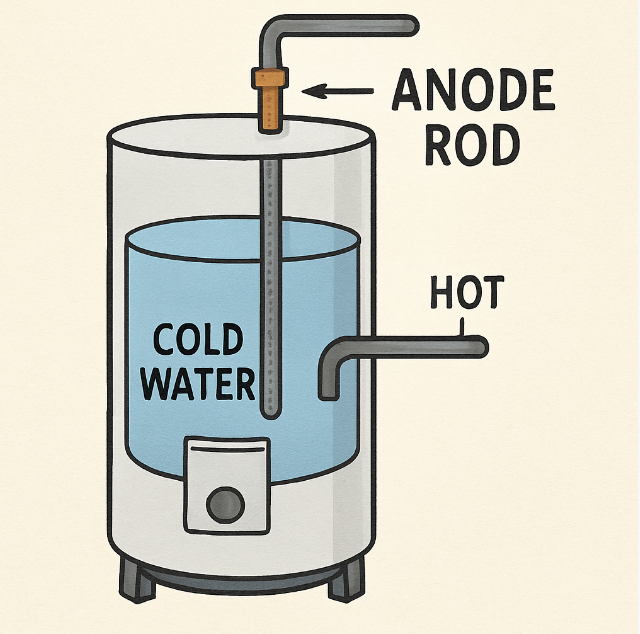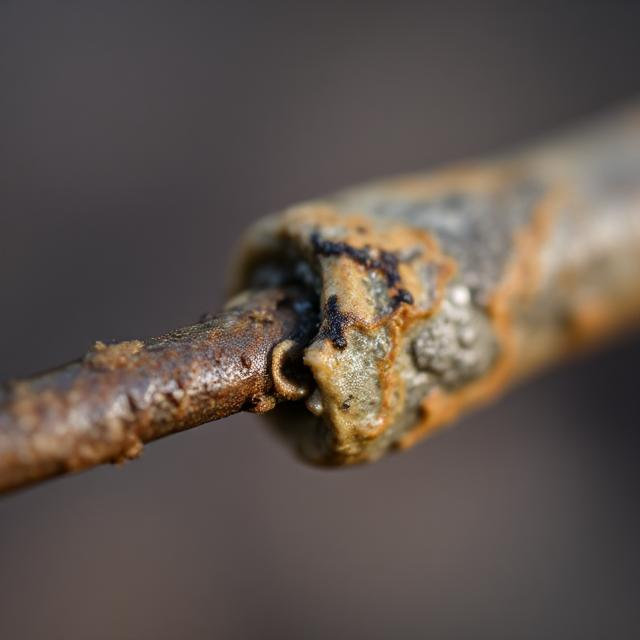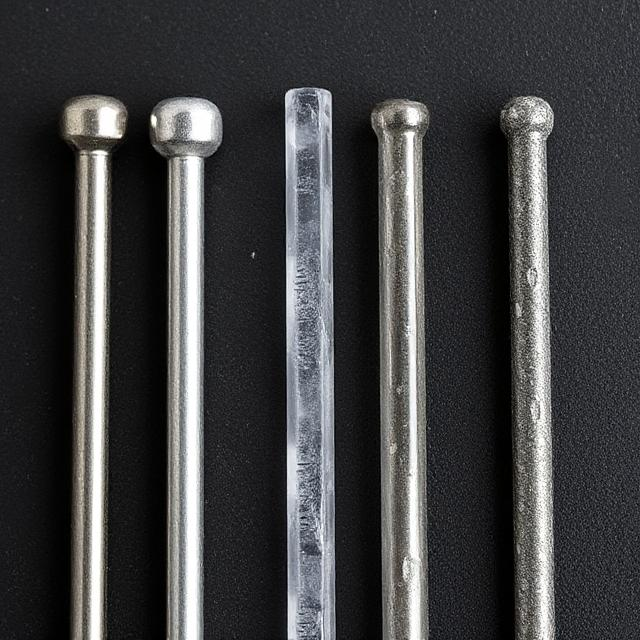Anode rods are vital for water heater health. They prevent tank corrosion, extending the heater's lifespan. But how long do anode rods last? Typically, they last 3 to 5 years, depending on water quality and usage. Understanding anode rod maintenance is crucial. Regular checks can prevent costly repairs and extend the rod's life. Signs of anode rod issues include rusty water and sulfur smells. Addressing these early can save your water heater. This guide will explore anode rod lifespan, maintenance tips, and how to spot issues. Stay informed to protect your investment.
An anode rod is a critical component of your water heater. It's designed to corrode instead of the tank itself, providing crucial protection. By sacrificing itself, the anode rod prevents rust from attacking your water heater’s metal parts.
The anode rod is often referred to as a sacrificial rod. It corrodes, protecting the metal tank from rusting. This process significantly extends the lifespan of your water heater.
Key functions of an anode rod include:
Preventing rust and corrosion
Extending water heater life
Reducing the need for costly repairs
Understanding the role of anode rods highlights their importance in water heater maintenance. Proper care can save money and stress over time.

Anode rods typically last between 3 to 5 years. However, this lifespan can vary significantly based on several factors. Water quality, usage patterns, and maintenance routine all influence how long an anode rod will function effectively.
For instance, if you live in an area with hard water, the minerals can wear down the rod faster. This could reduce the lifespan to about 2 to 3 years. Regular inspection and replacement when necessary can prevent significant issues.
Signs that it's time for a replacement often include rusty water or a sulfur-like smell. By monitoring these signs, you can address problems early. Keeping an eye on your water heater's performance is essential.
Here are key factors affecting lifespan:
Water quality and hardness
Frequency of water heater usage
Regularity of maintenance checks
Water heater type (tank vs. tankless)
Anode rod material
Regular maintenance and understanding the water conditions can lead to cost savings. It ensures your water heater remains efficient and long-lasting.
Several factors can influence how long your anode rod will last. Water quality is one of the most critical elements. High mineral content (hard water) can speed up the corrosion process, resulting in a shorter lifespan. Conversely, very soft water can also accelerate corrosion, as it lacks minerals to buffer the electrochemical reaction.
The frequency of usage also plays a significant role. Water heaters in homes with large families or commercial settings work harder and may require more frequent anode rod checks. The more hot water consumed, the more the anode rod is exposed to the corrosive elements in the water.
Water heater temperature settings can also impact anode rod life. Higher temperatures can accelerate chemical reactions, potentially leading to faster anode rod degradation. Maintaining a moderate temperature can help prolong its life.
Finally, the type of anode rod material (magnesium, aluminum, zinc, or powered) directly affects its longevity and effectiveness, as discussed in a later section.
Consider these factors to understand your rod's longevity:
Water mineral content and hardness (hard vs. soft water)
Usage frequency of the water heater
Consistent maintenance and inspection practices
Water heater temperature settings
Anode rod material
Understanding these elements helps in planning timely replacements. Regular checks ensure the anode rod fulfills its purpose of protecting the heater. Keeping an eye on these factors prolongs the unit’s efficiency and durability.

Identifying signs of issues with your anode rod is crucial. One common symptom is rusty or discolored water. If you notice a change in water color, especially when drawing hot water, an inspection is due. This indicates that the anode rod is no longer effectively protecting the tank, and the tank itself may be starting to corrode.
A sulfuric or rotten egg smell is another indicator. This scent often signals that the anode rod is no longer effectively controlling bacteria growth within the tank, or that the rod material (especially magnesium) is reacting with sulfates in the water to produce hydrogen sulfide gas.
Additionally, unusual noises from your water heater, such as popping or rumbling, can hint at a failing anode rod or excessive sediment buildup, which often goes hand-in-hand with a neglected anode rod.
Knowing the signs helps avoid larger problems:
Rusty or discolored hot water
Sulfur or rotten egg smell from hot water
Unusual noises (popping, rumbling) from the heater
Reduced hot water pressure (can be related to sediment buildup)
Regular checks are important in addressing these problems promptly. Replacing the rod when necessary can prevent costly damages and extend the life of your water heater. Timely action ensures the continued protection of your water heater.

Anode rods come in different materials, each with unique benefits and suitability for various water conditions. Choosing the right type is key to maximizing lifespan and effectiveness. Common materials include magnesium, aluminum, and zinc, with a newer option being powered anode rods.
Magnesium rods are popular for their high electrochemical potential, making them very effective at attracting corrosive elements. However, they tend to corrode faster, especially in hard water, and can sometimes contribute to sulfur odors. Their lifespan is generally 3-5 years.
Aluminum rods are a good alternative for hard water conditions and generally last longer than magnesium rods, often 4-6 years. They are also effective but have a slightly lower electrochemical potential. Some aluminum rods are alloyed with zinc to enhance performance and reduce odors.
Zinc rods are typically aluminum-zinc alloy rods. They offer an additional advantage—helping reduce sulfur odors in water heaters, making them a good choice if you experience this issue. Their lifespan is similar to aluminum, around 4-6 years.
Powered anode rods represent a significant advancement. Instead of sacrificing themselves, they use a small electrical current to prevent corrosion. They are much more expensive upfront but can last for the entire life of the water heater (20+ years) and are highly effective in all water conditions, including very soft water where traditional rods struggle.
Consider these options based on your water type and specific needs:
| Anode Rod Type | Typical Lifespan | Best Suited For | Pros | Cons |
|---|---|---|---|---|
| Magnesium | 3-5 years | General use, good water quality | Highly effective corrosion protection | Corrodes faster, can cause sulfur odor in some water |
| Aluminum | 4-6 years | Hard water, general use | Longer lasting, good for hard water | Less effective than magnesium in some cases |
| Aluminum/Zinc Alloy | 4-6 years | Hard water, sulfur odor issues | Reduces sulfur odors, good for hard water | Similar to aluminum, slightly more expensive |
| Powered | 20+ years (life of heater) | All water types, especially soft water | Very long lasting, highly effective, eliminates odors | High upfront cost, requires electrical outlet |
Understanding your water quality and specific issues (like odors) helps in selecting the most suitable rod. Choose wisely to ensure maximum protection and performance for your water heater.

Regular maintenance of anode rods is crucial for extending their lifespan and, by extension, your water heater's life. By regularly inspecting and replacing them, you protect your water heater from costly damages. It is recommended to start by checking the anode rod every one to two years, especially after the first year of a new water heater installation, to establish a baseline for your specific water conditions.
Turn off the water heater: For electric heaters, switch off the circuit breaker. For gas heaters, turn the gas valve to the “pilot” or “off” position.
Shut off the cold water supply: Close the cold water inlet valve to the water heater.
Drain some water from the tank (optional but recommended): Attach a garden hose to the drain valve at the bottom of the water heater and open it. Drain a few gallons into a bucket to reduce pressure and make rod removal easier. Close the drain valve when done.
Locate and remove the anode rod: The anode rod is usually located at the top of the water heater, often under a plastic cap or insulation, and may be integrated with the hot water outlet. Use a socket wrench (typically 1 1/16 or 1 1/4 inch) to unscrew it. It might be tight, so a breaker bar can be helpful.
Inspect the rod for wear: Examine the removed anode rod. Look for signs of significant corrosion, pitting, or if it's less than half its original diameter (typically 1/2 inch thick). If the steel core wire is exposed for more than 6 inches, it's definitely time for a replacement.
Replace if necessary: If the rod is heavily corroded or significantly reduced in size, replace it with a new one of the appropriate type and size for your water heater. Apply Teflon tape or pipe dope to the threads of the new anode rod before screwing it in.
Restore water and power: Once the new rod is installed (or the old one re-installed if still good), open the cold water supply valve, let the tank fill completely (open a hot water faucet in your house to let air escape), and then turn the power/gas back on.
Perform this regularly to prevent premature failures and improve energy efficiency. Remember, an intact anode rod shields the water heater from corrosion.

Extending the life of your anode rod and, consequently, your entire water heater, is both simple and effective. It's all about proactive maintenance and understanding your home's specific conditions. Start by understanding your local water quality, as this is a primary determinant of anode rod lifespan.
Install a water filtration or softening system: If you have hard water, a water softener can significantly reduce mineral buildup, slowing down the corrosion of the anode rod and preventing sediment accumulation in the tank.
Regularly flush your water heater: Sediment buildup at the bottom of the tank can cover the anode rod, making it less effective, and can also lead to premature tank failure. Flushing the tank annually helps remove these deposits.
Adjust the thermostat to a moderate temperature setting: While hot water is desirable, excessively high temperatures (above 120-125°F or 49-52°C) can accelerate the electrochemical reactions that corrode the anode rod. A moderate setting is often sufficient and can prolong the rod's life.
Consider a powered anode rod: As discussed, while more expensive upfront, a powered anode rod can last for decades and eliminate the need for frequent replacements, offering long-term savings and peace of mind.
Regularly inspect and replace the anode rod: Adhere to the inspection schedule (every 1-2 years) and replace the rod as soon as signs of significant wear are observed. This is the most direct way to ensure continuous protection.
These strategies not only prolong anode rod lifespan but also enhance overall water heater performance and energy efficiency. Taking small preventive steps ensures long-term savings and reliability. By maintaining your water heater, you safeguard your home against unexpected breakdowns and costly replacements.
Anode rods often spark questions among homeowners and DIY enthusiasts. Knowing the answers can prevent future hassles and ensure your water heater operates optimally. Let’s clear up some common queries.
Generally, every 3 to 5 years. However, this varies significantly based on water quality (hard vs. soft water), usage patterns, and the type of anode rod. It's best to inspect it annually after the first year to establish a personalized replacement schedule.
Most standard tank-style water heaters are designed to accommodate anode rods. However, always check the manufacturer's specifications for your particular model to ensure compatibility and the correct size/type of rod.
Yes, anode rods work with soft water, but soft water can sometimes accelerate the corrosion of traditional magnesium or aluminum anode rods. This is because soft water often has fewer dissolved minerals, making it more conductive and potentially more aggressive towards the anode. In such cases, a powered anode rod is often the most effective and long-lasting solution.
For many homeowners with basic plumbing knowledge and tools, replacing an anode rod is a feasible DIY project. However, it involves working with water and potentially electricity or gas, so safety precautions are paramount. If you are uncomfortable, it's always best to consult a qualified plumber.
Anode rods can be purchased at most hardware stores, home improvement centers, and online retailers. Ensure you buy the correct length and diameter for your water heater, and consider the material type based on your water conditions.
The anode rod, though often overlooked, is a critical component in extending the life of your water heater and preventing costly repairs. Understanding its function, recognizing the signs of wear, and performing regular maintenance are key to ensuring your hot water supply remains consistent and free from issues. By choosing the right type of anode rod for your water conditions and adhering to a proactive maintenance schedule, you can significantly prolong the efficiency and longevity of your water heater, safeguarding your investment for years to come.